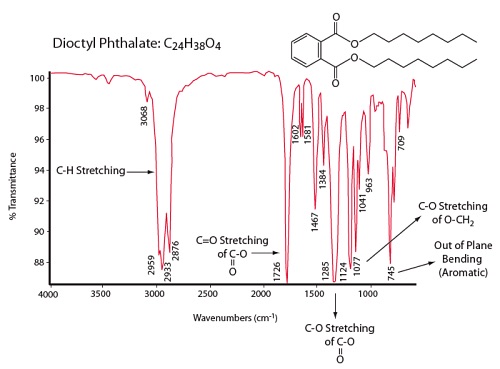Fourier Transform Infrared Spectroscopy (FTIR) Services
Home » Fourier Transform Infrared Spectroscopy (FTIR) Services
Fourier Transform Infrared Spectroscopy (FTIR) is a technique that is extremely useful for the characterization of organic materials (including polymers) and certain inorganic compounds. The spectra obtained by FTIR provide information about the presence of specific molecular structures. Though important in all FTIR analyses, skillful sample preparation and knowledgeable spectral interpretation are especially critical in the identification of unknown substances.
Chemical identification of an unknown material is often a key step in determining the root cause of a contamination problem. When the contaminant is organic in nature, the identification process can be particularly challenging, since many thousands of organic compounds exist. The difficulty in identifying unknowns is complicated by the fact that most contaminants are mixtures of two or more different compounds.
FTIR is a spectroscopic technique based on the absorption of infrared photons that excite vibrations of molecular bonds. A spectrum of characteristic bands is produced that can be used as a fingerprint to help identify and characterize the sample. FTIR analysis can be conducted in transmission or reflection modes.

The specific FTIR analysis mode, as well as the sample preparation method, is selected based on the particular characteristics of the sample. For transmission or reflection FTIR, samples must be thinned to between 0.1 to 10 µm prior to analysis. Reflection mode analysis is limited to thin materials on a reflective substrate or to somewhat pliable materials which can make good contact with a hard attenuated total reflection (ATR) crystal. ATR Infrared Spectroscopy is a special form of reflectance FTIR where the IR radiation makes several passes through the ATR crystal and with each pass a relatively thin layer of the adjacent sample is analyzed.
The analytical spot size in FTIR can range from several millimeters in diameter down to 15 µm with the use of a microscope attachment. For the detection of a minor component in a mixture of compounds, the component should be present at levels of at least a few percent by weight, though the detection limit can be higher or lower, depending on the molecular structures of the particular compounds.
Because the fingerprints of many organic compounds are unique, FTIR is most commonly used to provide qualitative compound identification. Quantitative FTIR can be a powerful technique when the appropriate calibration samples are available. FTIR is applicable to solids, liquids, and gases.
COMMON APPLICATIONS
- Identification of unknown organic and some inorganic materials, often mixtures and often microscopic
- Detection and characterization of organic and some inorganic additives in polymers at levels as low as a few percent
- Characterization of changes in chemical structure of organic materials as a result of polymer cure, sterilization, heat treatment, plasma treatment, etc.
- Quantification of O and H in Si, and H in SiN wafers (Si-H vs. N-H)
- Characterization of total non volatile residue or condensable volatiles
STRENGTHS
- Capable of identifying organic functional groups and specific organic compounds
- Extensive spectral libraries to aid in compound identification
- Ambient analysis conditions (no vacuum required so suitable for volatile compounds)
- Large sample size can be accommodated
- Often non-destructive
- Minimum analysis area: ~15 micron
- Semi-quantitative in certain cases
LIMITATIONS
- Limited surface sensitivity
- Minimum analysis area: ~15 micron
- Limited inorganic information
- Qualitative information only unless calibration samples are used
TECHNIQUE COMPARISONS
Other techniques complementary to FTIR Spectroscopy include Raman Spectroscopy, X-ray Photoelectron Spectroscopy (XPS), Time-of-Flight Secondary Ion Mass Spectrometry (TOF-SIMS), Gas Chromatography-Mass Spectrometry (GC-MS) and Liquid Chromatography-Mass Spectrometry (LC-MS). All of these techniques can be used to characterize organic materials to varying degrees.
Raman is also a vibrational spectroscopy technique that, in many cases, provides complementary information. Both techniques provide organic compound identification; and are not limited simply to functional group identification. The minimum spot size in Raman is 1 µm, significantly smaller than for FTIR. Certain samples analyzed by Raman will show interference from fluorescence. Also, in Raman spectroscopy, if inorganic carbon is present it can dominate and mask signals from organic compounds.
XPS provides information on short-range chemical bonding of a sample while TOF-SIMS provides information on its molecular composition. The depth of analysis with XPS and TOF-SIMS is on the order of 10-100Å so they can sometimes be too surface sensitive when it comes to characterizing the bulk of unknown organic materials if the sample is not pristine and the surface has been contaminated with other impurities. GC-MS and LC-MS are commonly used tools in the characterization of organic compounds. Both techniques have the ability to separate mixtures of samples into their individual components and characterize or identify each of the constituents. These techniques typically require the sample to be vaporized or dissolved prior to analysis, complicating these experiments.
FTIR AT EAG
Our FTIR scientists are highly educated and knowledgeable and are leaders in the analysis of complex organic mixtures. We pride ourselves in having experience with many different types of materials and applications. We provide accurate data, complete written reports, fast turnaround times, and person-to-person service.
Would you like to learn more about Fourier Transform Infrared Spectroscopy (FTIR)?
Contact us today for your Fourier Transform Infrared Spectroscopy (FTIR) Service needs . Please complete the form below to have an EAG expert contact you.